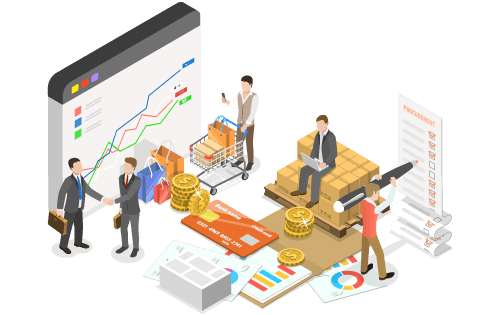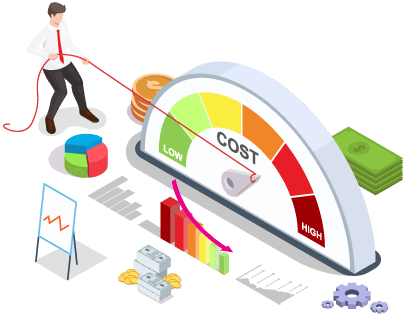Making Better Purchasing Decisions
Built For


- Understand purchasing needs
- Perform market and research analysis
- Leverage technology
- Strengthen supplier partnerships
- Manage costs
- Maintain continuous improvements
Making Better Purchasing Decisions
Making smart purchasing decisions is vital to running a successful business, whether you’re buying products for resale or raw materials for manufacturing. Every choice you make impacts your bottom line, from securing the best prices to ensuring you have the right amount of stock.
With the right strategies, you can optimize your purchasing process, reduce costs, and keep your operations running smoothly.
Having a solid plan for purchasing is more important than ever. This means knowing exactly what your business needs, doing thorough market research, and leveraging technology like inventory management software. These tools can help you stay on top of your inventory, forecast demand, and make informed purchasing decisions.
Today, we’ll explore practical tips and best practices for making better purchasing decisions. We’ll cover everything from understanding your purchasing needs to researching the market and using inventory management software to streamline your process. By the end, you’ll have a clear roadmap to enhance your purchasing strategy and keep your business thriving. Let’s get started!
Step 1 for Better Purchasing Decisions: Understanding Purchasing Needs
Before you make any purchasing decisions, it’s essential to have a clear understanding of what your business truly needs. This involves looking at both your current requirements and anticipating future demands. Here’s how you can get started:
Identifying Business Requirements
First things first, know what you need. Are you buying products for resale or raw materials for manufacturing? Define your specific requirements based on your business model. For instance, an online retailer might need to stock up on popular items, while a manufacturer needs raw materials that meet quality standards.
Analyzing Historical Data and Trends
Dive into your past sales data to identify patterns. Which products or materials are consistently in demand? Are there seasonal trends you should be aware of? Historical data can provide valuable insights into what you should purchase and in what quantities.
Considering Future Needs
Don’t just focus on the present; think ahead. Are there upcoming trends or market shifts that could impact demand? A new product launch or a marketing campaign may boost sales. Anticipating these changes can help you make more strategic purchasing decisions.
Leveraging Inventory Management Software
This is where technology comes into play. Inventory management software tracks your stock levels in real time, forecasts future demand, and even alerts you to reorder when quantities reach a pre-defined threshold. Inventory software ensures you’re always purchasing the right amount of stock, avoiding shortages and overstock situations.
Collaborating with Other Departments
Purchasing decisions shouldn’t be made in a vacuum. Collaborate with other departments, such as sales, marketing, and production, to comprehensively understand your needs. Their input can help you make more informed decisions that align with your business strategy.
Understanding your purchasing needs is the first step toward making better decisions. By identifying your requirements, analyzing data, anticipating future demands, leveraging technology, and collaborating with your team, you can lay a solid foundation for a more efficient and effective purchasing process.
Step 2 for Better Purchasing Decisions: Research and Market Analysis

Once you clearly understand your purchasing needs, the next step is to conduct thorough research and market analysis. This ensures you make informed decisions based on the best available options. Here’s how to approach this step:
Conduct Thorough Market Research
Start by gathering as much information as possible about your needed products or raw materials. Research different suppliers, product specifications, and market trends. Use online resources, industry publications, and trade shows to view what’s available comprehensively.
Evaluate Suppliers and Vendors
Choosing the right suppliers is crucial. Evaluate potential vendors based on several factors, including price, quality, reliability, and delivery times. Don’t just go for the cheapest option; consider the overall value they offer. Look for suppliers with good reputations and positive reviews from other businesses.
Place High-Turnover Items in Accessible Locations
- Identify items that are frequently picked and place them in the most accessible locations. This reduces the time and effort required to retrieve them.
- Keep high-turnover items near packing and shipping areas to streamline the order fulfillment process.
Compare Product Features, Quality, and Prices
Create a comparison chart to weigh the pros and cons of different products and suppliers. Consider the features and quality of the products alongside their prices. Paying a little more for higher quality can save money in the long run by reducing defects and returns.
Leverage Inventory Management Software
Inventory management software provides data-driven insights into supplier performance, helping you compare prices and quality, track market trends, and make more informed and strategic purchasing decisions.
Understand Market Conditions
Stay updated on the broader market conditions that affect your purchasing decisions. This includes factors like economic trends, supply chain disruptions, and changes in consumer behavior. Knowing these conditions can help you anticipate price changes or availability issues.
Seek Feedback and Reviews
Don’t underestimate the power of feedback. Seek reviews and testimonials from other businesses that have dealt with the suppliers you’re considering. Their experiences can provide valuable insights into suppliers’ and products’ reliability and quality.
By conducting thorough research and market analysis, you ensure you make well-informed purchasing decisions. This step helps you find the best products at the best prices from the most reliable suppliers, setting the stage for efficient and cost-effective purchasing.
Step 3 for Better Purchasing Decisions: Utilizing Technology
Leveraging technology is essential for making smarter purchasing decisions. With the right tools, you can streamline your purchasing process, gain valuable insights, and improve efficiency. Here’s how to utilize technology effectively:
Implementing Inventory Management Software
Inventory management software is a must-have tool for any product-based business. It helps you track your stock levels in real time, set reorder points, and generate detailed reports on inventory movements. This ensures that you always know what you have in stock and what needs to be ordered, helping you avoid stockouts and overstock situations.
Using Data Analytics to Forecast Demand
Data analytics can transform the way you forecast demand. You can predict future demand more accurately by analyzing historical sales data, seasonal trends, and market conditions. This allows you to make informed purchasing decisions based on anticipated needs rather than just guessing. Inventory management software often includes built-in analytics tools that can simplify this process.
Setting Reorder Points
Automation can remove a lot of the guesswork from purchasing. Establishing reorder point alerts in your inventory management software when stock levels fall below a certain threshold ensures you always have the necessary inventory on hand without having to constantly monitor stock levels.
Step 4 for Better Purchasing Decisions: Supplier Relationship Management
Building and maintaining solid relationships with your suppliers is crucial for successful purchasing. Good supplier relationships can lead to better prices, improved quality, and more reliable delivery times. Here’s how to effectively manage your supplier relationships:

Build Strong Relationships with Reliable Suppliers
Start by identifying and partnering with reliable suppliers who can consistently meet your needs. Building a solid relationship with these suppliers can lead to benefits like priority treatment, better terms, and early access to new products. Take the time to understand their business, challenges, and capabilities.
Communicate Clearly and Regularly
Open and transparent communication is the foundation of any good relationship. Keep your suppliers informed about your needs, forecasts, and any changes in your business that might affect them. Regular communication helps build trust and ensures that both parties are on the same page.
Negotiate Better Terms and Prices
Don’t be afraid to negotiate. A strong relationship with your suppliers can give you leverage to negotiate better prices, favorable payment terms, and other benefits. Approach negotiations with a win-win mindset, aiming for agreements that benefit both parties.
Assess Supplier Performance Regularly
Regularly evaluate your suppliers to ensure they are meeting your expectations. Look at product quality, delivery times, pricing, and customer service. Use this information to provide constructive feedback and make informed decisions about continuing or adjusting your supplier relationships.
Manage Contracts and Agreements
Keep all contracts and agreements with your suppliers well-documented and organized. Ensure you understand the terms and conditions and monitor compliance to avoid disputes. Clear contracts help protect both parties and set expectations from the start.
Resolve Issues Promptly and Fairly
Problems are inevitable, but how you handle them can make a big difference. Address any issues with your suppliers promptly and fairly. Work together to find solutions and prevent similar problems in the future. A collaborative approach can strengthen your relationship and build mutual respect.
Leverage Technology for Supplier Management
Use technology to streamline your supplier management processes. Inventory management software can help you track supplier performance, manage contracts, and facilitate communication.
Develop Long-Term Partnerships
Aim to develop long-term partnerships with your key suppliers. Long-term relationships can lead to more stable pricing, consistent quality, and better alignment with your business goals. Invest in these relationships by regularly reviewing and renewing your agreements and finding new ways to collaborate and grow.
Be a Good Customer
As you expect your suppliers to meet your standards, strive to be a good customer. Pay your invoices on time, provide clear and timely feedback, and honor your commitments. Being a reliable and respectful customer can enhance your reputation and make suppliers more willing to go the extra mile for you.
Managing supplier relationships effectively is essential for making better purchasing decisions. By building solid relationships, communicating openly, negotiating wisely, and leveraging technology, you can create a collaborative and mutually beneficial partnership with your suppliers. This not only improves your purchasing process but also contributes to the overall success of your business.
Step 5 for Better Purchasing Decisions: Cost Management
Effective cost management is a critical aspect of making better purchasing decisions. By carefully managing costs, you can improve your business’s profitability and ensure you get the best value for your money. Here’s how to approach cost management:

Budget for Purchases
Start by setting a clear budget for your purchases. This involves forecasting your purchasing needs and allocating funds accordingly. A well-defined budget helps you control spending and avoid unnecessary expenses. Regularly review and adjust your budget based on actual spending and changes in your business needs.
Identify Opportunities for Cost Savings
Look for ways to save money without compromising on quality. This could involve negotiating better prices with suppliers, buying in bulk to take advantage of discounts, or finding more cost-effective alternatives. Regularly review your purchasing processes and expenses to identify where you can cut costs.
Leverage Inventory Management Software
Inventory management software can play a crucial role in cost management. It helps you track expenses, manage budgets, and identify cost-saving opportunities. Inventory software allows you to make more strategic purchasing decisions by providing real-time data on inventory levels and spending. It can also help you avoid overstocking and stockouts, leading to unnecessary costs.
Implement Cost Control Measures
Establish cost control measures to keep your purchasing expenses in check. This might include setting spending limits, requiring multiple quotes for high-value purchases, and regularly reviewing and approving purchase orders. Cost control measures help ensure that all purchases are necessary and cost-effective.
Analyze Supplier Contracts and Terms
Carefully review supplier contracts and terms to identify hidden costs or savings opportunities. Look for clauses related to bulk discounts, early payment discounts, or penalties for late payments. Understanding and negotiating these terms can reduce your overall purchasing costs.
Monitor and Analyze Spending
Regularly monitor and analyze your spending to identify trends and potential issues. Use reports and analytics from your inventory management software to track expenses and compare them against your budget. This helps you stay on top of your spending and adjust as needed to stay within budget.
Manage Inventory Levels
Proper inventory management is essential for controlling costs. Too much inventory ties up capital and increases storage costs, while too little inventory can lead to stockouts and lost sales. Use inventory management software to maintain optimal inventory levels and avoid unnecessary expenses.
Train Employees on Cost Management
Ensure that your employees understand the importance of cost management and are trained on best practices. This includes teaching them how to use inventory management software, negotiate with suppliers, and identify cost-saving opportunities. Well-informed employees can contribute significantly to your cost management efforts.
Understand the True Landed Cost
Understanding the landed cost of your products is crucial for accurate pricing and cost management. Landed cost includes the total cost of purchasing and delivering products to your warehouse. This encompasses the purchase price, shipping fees, customs duties, taxes, insurance, and other costs of getting the product to its final destination. By calculating the landed cost, you can:
- Ensure Accurate Pricing: Knowing the true cost of your products helps you set prices that cover all expenses and ensure profitability.
- Identify Cost-Saving Opportunities: By breaking down the components of landed cost, you can identify areas where you might reduce expenses, such as negotiating better shipping rates or finding suppliers with lower customs fees.
- Improve Budgeting and Forecasting: Accurate landed cost information allows for better budgeting and forecasting, helping you plan for future expenses and manage cash flow effectively.
- Optimize Supplier Selection: Comparing landed costs from different suppliers helps you make more informed decisions about which suppliers offer the best overall value.
Step 6 for Better Purchasing Decisions: Continuous Improvement
Making better purchasing decisions is not a one-time effort but an ongoing process. Continuous improvement helps ensure that your purchasing strategies remain effective and aligned with your business goals. Here’s how to cultivate a culture of continuous improvement in your purchasing process:

Regularly Review and Update Purchasing Strategies
Your purchasing strategies should evolve with your business and the market. Review them regularly to ensure they are still relevant and effective. This includes assessing your supplier relationships, purchasing policies, and cost management practices. Adjust as necessary to address any changes in your business needs or market conditions.
Gather Feedback from Stakeholders
Involve key stakeholders in the review process. Gather employee, supplier, and customer feedback to gain perspectives on your purchasing practices. This feedback can provide valuable insights into areas that need improvement and help you identify new opportunities for optimization.
Adapt to Changes in the Market and Business Environment
The market and business environment are constantly changing. Stay informed about industry trends, economic shifts, and technological advancements that could impact purchasing decisions. Be prepared to adapt your strategies to respond to these changes, ensuring you remain competitive and efficient.
Leverage Technology for Continuous Improvement
Technology can support continuous improvement by providing real-time data and analytics. Use inventory management software to monitor your purchasing performance, track key metrics, and identify areas for improvement. Advanced features like automated reporting and predictive analytics can help you make data-driven decisions and continuously refine your purchasing process.
Implement Best Practices and Learning from Others
Stay updated on industry best practices and learn from the successes and challenges of other businesses. Attend industry conferences, participate in webinars, and read relevant publications to stay informed about new trends and techniques. Implementing proven best practices can help you enhance your purchasing strategies.
Encourage a Culture of Innovation
Foster a culture of innovation within your team. Encourage employees to suggest new ideas and improvements for the purchasing process. Recognize and reward innovative thinking and provide opportunities for professional development and training. An innovative culture helps keep your purchasing strategies fresh and effective.
Measure and Celebrate Success
Set clear goals and key performance indicators (KPIs) to measure the success of your purchasing strategies. Regularly track your progress and celebrate achievements. Recognizing success motivates your team and reinforces the importance of continuous improvement.
Conduct Periodic Audits and Assessments
Periodically conduct audits and assessments of your purchasing process. This can help you identify inefficiencies, compliance issues, or areas needing improvement. Use the findings from these audits to make informed adjustments and ensure that your purchasing process remains robust and effective.
Continuous improvement in purchasing is essential for maintaining efficiency, reducing costs, and supporting your overall business objectives. By regularly reviewing and updating your strategies, gathering feedback, adapting to changes, leveraging technology, and fostering a culture of innovation, you can ensure that your purchasing decisions remain effective and aligned with your business goals. This ongoing commitment to improvement will help you stay competitive and achieve long-term success.
Call us at 817-870-1311





